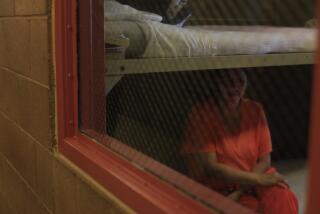Federal agency steps into valley fever investigation
The federal Centers for Disease Control and Prevention has stepped in to investigate outbreaks of valley fever in two California prisons, where more than three dozen inmates have died with the fungal disease.
Staff from the Atlanta-based centers’ disease investigation unit met with state prison health officials Tuesday, and another meeting is planned later this week. California’s health department formally requested the assistance last week on behalf of a court-appointed monitor after the state corrections department failed to follow through with repeated requests that it seek federal help.
Earlier this week, the court receiver, J. Clark Kelso, issued his own directive requiring Avenal and Pleasant Valley State Prisons to relocate about 3,200 inmates deemed at increased risk of developing a fatal reaction to the fungus, including all African Americans and those over 55. On Wednesday, Kelso broadened his directive to also include inmates with certain forms of diabetes.
Corrections officials, provided an advance copy of the policy two weeks ago, said they were still “evaluating” the directive. The department pointed out that the directive complicates efforts to comply with orders from the same federal courts to reduce crowding in all 33 state prisons. A plan from Gov. Jerry Brown to further reduce prison crowding by 9,000 inmates, in order to improve medical care throughout the system, is due by the end of Thursday.
“Any decision to shift thousands of inmates based on race and age into other facilities must be weighed with the risks such a dramatic move would pose to public and institutional safety and to the delivery of healthcare systemwide,” corrections spokesman Jeffrey Callison said.
Kelso’s office asked the Atlanta-based CDC for help in creating a new strategy to reduce the number of valley fever deaths and steps to prevent inmates and prison guards from being exposed to soil contaminated with the fungus spores.
In a report to U.S. District Judge Thelton Henderson on Wednesday, Kelso accused the state of an “anemic response,” saying California had done little beyond add air filters and door seals to keep out fungus-tainted dust.
Six years ago, the receiver asked state prison officials to transfer high-risk inmates out of the two prisons and to consider relocating all inmates if valley fever rates did not drop. As of this week, about 500 such high-risk inmates remained within the two prisons.
In Kelso’s court filing Wednesday, he included a health risk analysis that showed African American inmates housed in the two prisons have a 90% increased risk of valley fever. Latino inmates had a 30% increased risk, and those over 55 had a 60% increased risk.
ALSO:
Man guilty in 1987 murder of strip club owner Jimmy Casino
Search for O.C. hikers cost $160,000, but they won’t be billed
Shriver or Schwarzenegger: Whose reinvention is working better?
More to Read
Get the L.A. Times Politics newsletter
Deeply reported insights into legislation, politics and policy from Sacramento, Washington and beyond. In your inbox three times per week.
You may occasionally receive promotional content from the Los Angeles Times.











